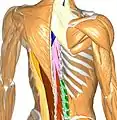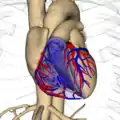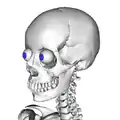Anatomography
Anatomography is an interactive website which supports generating anatomical diagrams and animations of the human body. The Anatomography website is maintained by the DBCLS (Database Center for Life Science) non-profit research institute located at the University of Tokyo. Anatomical diagrams generated by Anatomography, and 3D polygon data used on the website (called BodyParts3D), are freely available under the Creative Commons Attribution-ShareAlike license.[2]
  | |
| Available in | English or Japanese |
|---|---|
| Owner | Database Center for Life Science |
| Created by | Kousaku Okubo |
| URL | lifesciencedb.jp/bp3d |
| Commercial | No |
| Launched | 2009-02-09[1] |
| Current status | Active |
Content license | CC-BY-SA 2.1-ja[2] |
Description
Anatomography was launched on Feb. 9, 2009[1] by founder and chief director Kousaku Okubo, professor of the DNA Data Bank of Japan at the National Institute of Genetics.
Human body polygon data used in the site are called "BodyParts3D".[3] BodyParts3D polygon data are extracted from full-body MRI images. The MRI image set that BodyParts3D is based on is called "TARO". Taro is a common given name for males in Japanese, as John is in English. TARO is a 2mm * 2mm * 2mm voxel dataset of the human male created by the National Institute of Information and Communications Technology.[4] TARO was published freely in November, 2004.[5][6]
The construction process of BodyParts3D is as follows.[3]
- Phase 1: Additional anatomical segmentations were introduced in the original TARO data.
- Phase 2: Then, missing details were supplemented and blurred contours were clarified using a 3D editing program by referring to textbooks, atlases,[7] and mock-up models by medical illustrators.
- Phase 3: Further segmentation and data modification will continue in collaboration with clinical researchers until sufficient concept coverage is achieved.
BodyParts3D polygon data are distributed in the OBJ file format. The entire data file's size is 127 MB (polygon reduced) and 521 MB (high quality) as of version 3.0.[8] The number of body parts (organs) registered in BodyParts3D is 1,523 as of version 3.0.[7]
License
Images generated by Anatomography and the polygon data included in BodyParts3D are licensed under the Creative Commons license,[2] in hope of widening usage and democratizing medical knowledge.[9]
Funding
The BodyParts3D/Anatomography project was funded by MEXT (Japanese Ministry of Education, Culture, Sports, Science and Technology) from FY2007 to FY2010.[10][11] As of FY2011, the project has been funded by the JST (Japan Science and Technology Agency).[11]
Reception
Diagrams from Anatomography are used, for example, in Canadian science TV show Le code Chastenay,[12] Internet encyclopedia Wikipedia, as lecture material in universities, and elsewhere to share knowledge.[9] About usage of Anatomography on websites like Wikipedia and Wikimedia Commons, developers say "spreading of usages by anonymous users on like Wikipedia and Wikimedia Commons is what we had expected."[9]
Technical features
BodyParts3D/Anatomography project uses the Foundational Model of Anatomy (FMA). The FMA is an open-source anatomical ontology developed and maintained by the Structural Informatics Group at the University of Washington. In BodyParts3D, each body-part is managed by an FMA identifier (FMAID) defined by the FMA. For example, the vertebral column is registered as FMA13478, the temporal lobe is registered as FMA61825, and so on.
Version history
Similar services
- Zygote Body - Free web service provided by the Zygote Media Group located in American Fork, Utah, US. Zygote Body was launched as Google Body on December 15, 2010. The polygon data used on the website is a commercial product. As of October, 2012, the price of its full-body polygon data is $13,995.[16]
- BioDigital Human - Free web service and commercial product provided by BioDigital, Inc. located in New York, New York, US. The BioDigital Human was published in 2011. The web site won a SXSW Interactive Award in 2013.
Others
A few tutorial videos on using Anatomography are available on YouTube,[17] see external links.
Additional images
 Bones and muscles.
Bones and muscles. Heart and its blood vessels.
Heart and its blood vessels. Skull and eyeballs.
Skull and eyeballs. Brain and frontal lobe.
Brain and frontal lobe. 3D printing of BodyParts3D foot bone data.
3D printing of BodyParts3D foot bone data. Painting colors on cervical vertebrae polygon data, included in BodyParts3D data, using MeshLab.
Painting colors on cervical vertebrae polygon data, included in BodyParts3D data, using MeshLab. Downloaded BodyParts3D polygon data, edited with Blender.
Downloaded BodyParts3D polygon data, edited with Blender. Chief director Kousaku Okubo at University of Tokyo conference.[18]
Chief director Kousaku Okubo at University of Tokyo conference.[18]
References
- Release notes (in Japanese). DBCLS. Retrieved 2012-10-12.
- FAQs - credit. (in Japanese) DBCLS. Retrieved 2012-10-12.
- Mitsuhashi, N; Fujieda, K; Tamura, T; Kawamoto, S; Takagi, T; Okubo, K (2009). "BodyParts3D: 3D structure database for anatomical concepts". Nucleic Acids Research. 37 (Database issue): D782–5. doi:10.1093/nar/gkn613. PMC 2686534. PMID 18835852.

- Nagaoka, T; Watanabe, S; Sakurai, K; Kunieda, E; Watanabe, S; Taki, M; Yamanaka, Y (2004). "Development of realistic high-resolution whole-body voxel models of Japanese adult males and females of average height and weight, and application of models to radio-frequency electromagnetic-field dosimetry". Physics in Medicine and Biology. 49 (1): 1–15. Bibcode:2004PMB....49....1N. doi:10.1088/0031-9155/49/1/001. PMID 14971769.
- 日本人の数値人体モデルDB「TARO」と「HANAKO」公開 2004/11/10 (in Japanese). ITMedia. Retrieved 2012-10-12.
- 報道発表:日本人平均成人男女の数値人体モデルデータベース公開のお知らせ 2004-11-10 (in Japanese). National Institute of Information and Communications Technology. Retrieved 2012-10-12.
- BodyParts3D Release Note (Release 3.0, 2011/6/20) DBCLS. Retrieved 2012-10-15.
- Download - BodyParts3D DBCLS. Retrieved 2012-10-15.
- 三橋 信孝、藤枝 香、今井 紫緒、武藤 勇、田村 卓郎、川本 祥子、高木 利久、大久保 公策 「BodyParts3DとAnatomography: 医学での情報共有を「動機付ける」素材」(in Japanese) シンポジウム「ライフサイエンスの未来へ~10年先のデータベースを考える~」/ Nobutaka Mitsuhashi, Kaori Fujieda, Shio Imai, Isamu Muto, Takuro Tamura, Shoko Kawamoto, Toshihisa Takagi and Kousaku Okubo "BodyParts3D and Anatomography: Materials motivating sharing information in medicine" Poster presentation at "Symposium: Toward the Future of Life Science - Thinking Databases of 10 Years Later" held in the University of Tokyo at 2010-10-05. Retrieved 2012-10-12.
- BodyParts3D Database Description Life Science Database Archive. Retrieved 2012-10-19.
- FAQ - About the Database Center for Life Science (DBCLS) Archived 2013-01-30 at the Wayback Machine DBCLS. Retrieved 2012-10-19.
- 「LE CODE CHASTENAY」Emission 48 Archived 2016-03-04 at the Wayback Machine, 2010-01-19 aired
- "BodyParts3D/Anatomography" Updates Archived June 5, 2010, at the Wayback Machine Posted on April 28, 2010. DBCLS. Retrieved 2012-10-16.
- BodyParts3D Release Note (Release 2.0, 2010/4/28) DBCLS. Retrieved 2012-10-15.
- "BodyParts3D Release Notes, v4.0". Retrieved 2015-11-18.
- Male Anatomy Collection 5.0 Archived 2016-01-28 at the Wayback Machine 3Dscience.com. (Zygote Media Group, Inc.). Retrieved 2012-10-19.
- Kawano, S; Ono, H; Takagi, T; Bono, H (2012). "Tutorial videos of bioinformatics resources: Online distribution trial in Japan named TogoTV". Briefings in Bioinformatics. 13 (2): 258–68. doi:10.1093/bib/bbr039. PMC 3294242. PMID 21803786.

- Conference "Balancing IP Protection and Data Sharing in Science" held at the University of Tokyo, 2009-10-05. Okubo's presentation in Japanese Archived June 10, 2013, at the Wayback Machine, just before Lawrence Lessig's lecture. Entire videos of each lecture are available on the conference website's program schedule page (partly Japanese, partly English) Archived February 4, 2013, at the Wayback Machine.